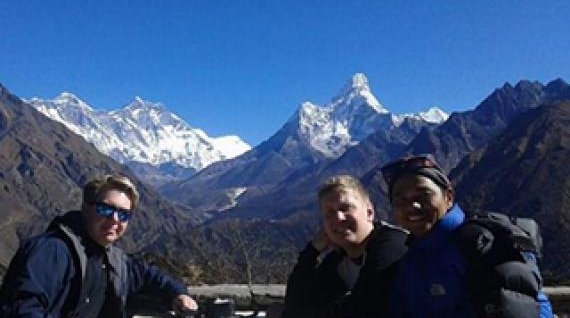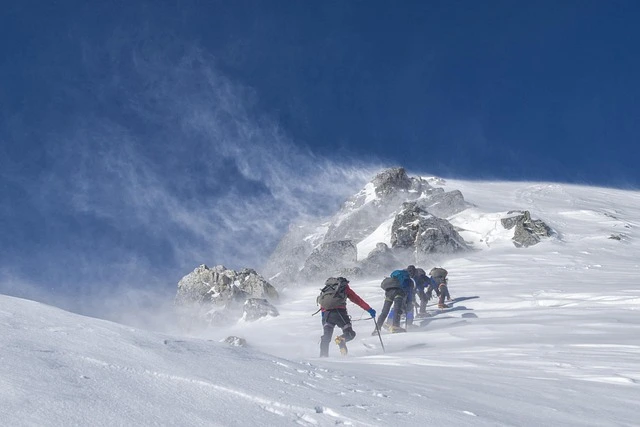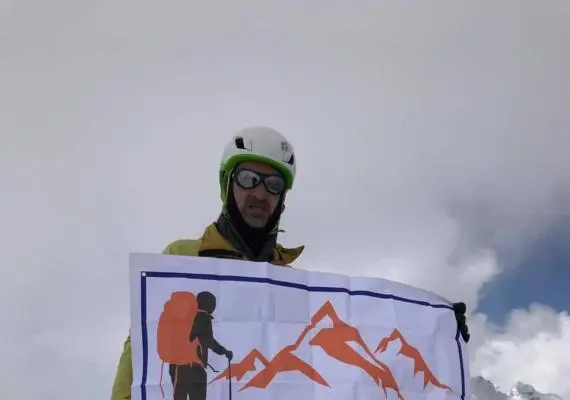Picture this: standing face-to-face with Mount Everest, the world's highest peak, without enduring weeks of grueling high-altitude climbing. The Everest View Trek makes this dream accessible to adventure seekers of all fitness levels. This remarkable journey through the heart of the Khumbu region offers breathtaking Himalayan panoramas, authentic Sherpa cultural experiences, and the thrill of trekking in Sagarmatha National Park—all wrapped into a manageable 8-day adventure.
Whether you're a first-time trekker wondering about fitness requirements or an experienced hiker seeking a shorter alternative to Everest Base Camp, this comprehensive guide covers everything you need to know about planning your Everest View Trek. From understanding the costs and permits to navigating teahouse accommodations and choosing the best season for your journey, we'll walk you through every aspect of this life-changing experience.
Trip Highlights
- Spectacular mountain views: Witness Everest, Lhotse, Nuptse, Ama Dablam, and Thamserku without extreme altitude challenges
- Everest View Hotel experience: Enjoy tea or lunch at the world's highest-placed hotel (13,000 ft)
- Vibrant Sherpa culture: Explore traditional villages and interact with legendary mountain people
- Namche Bazaar: Shop and acclimatize in the bustling "Sherpa Capital" of the Everest region
- Tengboche Monastery visit: Experience Buddhist spirituality at one of the most important monasteries in the Khumbu
- Thrilling Lukla flight: Land at one of the world's most exciting airports
- UNESCO World Heritage Site: Trek through pristine Sagarmatha National Park
- Comfortable teahouse stays: Enjoy warm hospitality and local cuisine throughout your journey
- Perfect acclimatization schedule: Gradual altitude gain reduces the risk of altitude sickness
- Professional guide support: Trek with experienced English-speaking guides who know every trail
Short 8-Day Itinerary
- Day 1: Fly Kathmandu to Lukla (2,840m), trek to Phakding (2,610m) - 3-4 hours
- Day 2: Trek from Phakding to Namche Bazaar (3,440m) - 5-6 hours
- Day 3: Acclimatization day in Namche - Hike to Everest View Hotel
- Day 4: Trek from Namche to Tengboche/Deboche (3,820m) - 5-6 hours
- Day 5: Morning monastery visit, trek back to Namche - 4-5 hours
- Day 6: Trek from Namche to Lukla - 6-7 hours
- Day 7: Fly from Lukla to Kathmandu (weather permitting)
- Day 8: Buffer day for flight delays / Departure
Understanding the Everest View Trek
What Makes This Trek Special?
The Everest View Trek strikes the perfect balance between adventure and accessibility. Unlike the demanding 12-14 day journey to Everest Base Camp, this trek offers equally stunning mountain vistas while keeping you at more comfortable altitudes. The highest point you'll reach is around 3,880 meters at Tengboche, significantly lower than EBC's 5,364 meters, making it ideal for those with limited time or concerns about extreme altitude.
This trek isn't just about mountains—it's a cultural immersion into the heart of Sherpa country. As you walk ancient trading routes, you'll pass through villages where life has remained largely unchanged for centuries. Prayer wheels spin in the mountain breeze, colorful prayer flags flutter against snow-capped peaks, and the warm smiles of local people remind you that the Himalayas offer more than just scenic beauty.
Who Is This Trek Perfect For?
The beauty of the Everest View Trek lies in its versatility. It's perfect for:
- First-time trekkers seeking a Himalayan experience without extreme challenges
- Families with teenagers looking for an adventure vacation
- Photographers wanting to capture Everest without the crowds at base camp
- Travelers with limited vacation time (just 8 days needed!)
- Anyone concerned about high altitude but still wanting the Everest experience
- Cultural enthusiasts interested in Buddhist monasteries and Sherpa villages
Planning Your Everest View Trek
Best Season for Everest View Trek
Timing your trek correctly can make the difference between clear mountain views and disappointing clouds. The best season for Everest View Trek falls into two main windows:
Spring Season (March-May) Spring brings stable weather, clear skies, and the added bonus of rhododendrons painting the hillsides in vibrant reds and pinks. Temperatures are moderate, with daytime highs around 15°C at lower elevations. This is peak season, so expect more trekkers on the trails and in the teahouses.
Autumn Season (September-November) Post-monsoon autumn offers the clearest mountain views of the year. The air is crisp, visibility extends for miles, and the weather remains generally stable. October is particularly popular, offering the perfect combination of clear skies and comfortable temperatures.
Winter and Monsoon Considerations While possible, winter treks (December-February) require proper cold-weather gear and mental preparation for temperatures that can drop to -10°C at night. Monsoon season (June-August) brings clouds, rain, and limited mountain views, though the valleys are lush and green.
Everest View Trek Cost Breakdown
Understanding the Everest View Trek cost helps you budget effectively for your adventure. Here's what to expect:
Package Costs: $800-$1,500 per person (depending on group size and inclusions)
What's Typically Included:
- Domestic flights (Kathmandu-Lukla-Kathmandu)
- All meals during the trek (breakfast, lunch, dinner)
- Teahouse accommodation throughout
- Experienced English-speaking guide
- Porter service (usually one porter per two trekkers)
- Sagarmatha National Park permit
- TIMS card (Trekkers' Information Management System)
- Basic first aid kit
Additional Expenses to Budget:
- International flights to Nepal
- Nepal visa ($30-50)
- Travel insurance (mandatory, must cover up to 4,000m)
- Personal gear and equipment
- Hot showers in teahouses ($3-5 each)
- Charging electronic devices ($2-4 per charge)
- Beverages and snacks
- Tips for guides and porters (typically $5-10 per day)
- Extra nights in Kathmandu
Essential Permits and Documentation
Before setting foot on the trail, you'll need two essential permits for your Everest View Trek:
Sagarmatha National Park Permit Everest View Cost: NPR 3,000 (approximately $30) This permit grants you access to the UNESCO World Heritage Site that protects the Everest region's unique ecosystem. You can obtain it in Kathmandu or at the park entrance in Monjo.
TIMS Card Cost: NPR 1,000 (approximately $10) The Trekkers' Information Management System card helps authorities track trekkers for safety purposes. Your trekking agency typically arranges this, or you can get it independently in Kathmandu.
The Journey Begins: Flight from Kathmandu to Lukla
The Legendary Lukla Flight
Your flight Kathmandu Lukla Everest View Trek marks the thrilling beginning of your adventure. This 35-minute flight on a small twin-otter aircraft offers stunning aerial views of the Himalayas before landing at Tenzing-Hillary Airport—often called the world's most dangerous airport due to its short, sloped runway perched on a mountainside.
Flight Tips:
- Book the earliest morning flight possible (6:00-7:00 AM) for the best weather
- Sit on the left side of the plane for optimal mountain views
- Be prepared for possible delays due to weather conditions
- Consider booking a buffer day in case of flight cancellations
- Weight limit is typically 15kg for checked baggage plus 5kg hand carry
Alternative Options During Peak Season
During peak seasons, flights might operate from Ramechhap (4-5 hours drive from Kathmandu) to reduce congestion at Kathmandu airport. While this adds a pre-dawn drive to your itinerary, it actually increases the reliability of your flight schedule.
Trekking Through the Heart of Sherpa Country
Day 1-2: Into the Khumbu Valley
Your first day's gentle walk from Lukla to Phakding serves as a perfect introduction to trekking rhythm. The trail descends through pine forests, crosses suspension bridges adorned with prayer flags, and passes through small villages where children wave enthusiastically at trekkers.
Day two brings the first real challenge as you climb steadily toward Namche Bazaar. The trail follows the Dudh Koshi River, crossing it several times on high suspension bridges. The final steep climb to Namche tests your fitness, but the reward of entering this mountain amphitheater makes every step worthwhile.
Namche Bazaar: The Sherpa Capital
Sherpa village Namche trekking experiences reach their peak in this bustling mountain town. At 3,440 meters, Namche Bazaar serves as the commercial hub of the Khumbu region. The town's terraced layout includes:
- Traditional Sherpa homes and modern lodges
- Bakeries serving fresh pastries and real coffee
- Gear shops for last-minute equipment needs
- Internet cafes (though connections can be slow)
- Banks and money changers
- The fascinating Sherpa Museum
- Saturday market where locals trade goods
Acclimatization Day: Everest View Hotel Trek
The acclimatization day in Namche isn't a rest day—it's one of the trek's highlights! The hike to Everest View Hotel trek takes you above Namche to the famous hotel at 3,880 meters. On clear days, the panoramic deck offers unobstructed views of Everest, Lhotse, Ama Dablam, and other peaks.
Pro tip: Start early (7:00 AM) for the clearest views. Clouds often roll in by late morning, obscuring the mountains.
The Spiritual Heart: Tengboche Monastery
The trail from Namche to Tengboche Monastery Everest View Trek ranks among the most beautiful sections of any Himalayan trek. After an initial descent to the Dudh Koshi River, you'll climb through rhododendron and pine forests to reach Tengboche at 3,867 meters.
Tengboche Monastery, the largest gompa in the Khumbu region, sits dramatically with Ama Dablam towering behind it. If you're fortunate enough to visit during morning or evening prayers, the sound of monks chanting against the backdrop of the world's highest peaks creates an unforgettable spiritual experience.
Accommodation: The Teahouse Experience
Understanding Teahouse Accommodation Everest View Trek
Teahouse accommodation Everest View Trek has evolved significantly over the years. These family-run lodges provide more comfort than many first-time trekkers expect:
Room Types:
- Twin-bedded rooms with basic furnishings
- Shared bathroom facilities (some lodges in Namche offer attached bathrooms)
- Thick blankets provided (bring a sleeping bag for extra warmth)
- Common dining area with a central heating stove
Meal Options:
- Dal Bhat (traditional Nepali meal) offers the best value and energy
- Western options like pasta, pizza, and pancakes available
- Vegetarian food recommended for food safety at altitude
- Hot drinks including tea, coffee, and hot chocolate
Booking Considerations: During peak season, teahouses can fill up quickly. Trekking with an agency ensures pre-booked accommodation, while independent trekkers might need flexibility in their itinerary.
Fitness and Preparation for Everest Lake Trek
Fitness Required for Everest View Trek
One of the most common concerns involves fitness required Everest View Trek. The good news? You don't need to be a marathon runner, but basic fitness greatly enhances your enjoyment.
Recommended Fitness Level:
- Ability to walk 5-6 hours daily with a light daypack
- Comfortable hiking uphill for extended periods
- Basic cardiovascular fitness
- No technical climbing skills required
Training Program (Start 2-3 Months Before):
- Regular walking or hiking (3-4 times weekly)
- Stair climbing or hill walking to build leg strength
- Gradually increase distance and elevation gain
- Practice with a weighted backpack (5-7kg)
- Include some cardio exercises like swimming or cycling
High Altitude Acclimatization Everest Region
Understanding high altitude acclimatization Everest region is crucial for a safe and enjoyable trek. While the Everest View Trek doesn't reach extreme altitudes, you'll still feel the effects of reduced oxygen above 3,000 meters.
Acclimatization Tips:
- Ascend gradually (the itinerary is designed for this)
- Stay hydrated (3-4 liters of water daily)
- Avoid alcohol and smoking
- Listen to your body and communicate with your guide
- Consider Diamox (consult your doctor first)
- "Climb high, sleep low" principle applied on acclimatization day
Common Altitude Symptoms:
- Mild headache
- Slight breathlessness
- Reduced appetite
- Difficulty sleeping
These symptoms are normal and usually improve with proper acclimatization. However, severe symptoms require immediate descent.
What to Pack: Essential Gear List for Everest Lake Trek
Clothing Layers
The key to comfort lies in the layering system:
Base Layer:
- Moisture-wicking thermal tops and bottoms
- Quick-dry underwear (4-5 pairs)
Insulation Layer:
- Fleece jacket or lightweight down jacket
- Fleece pants for cold evenings
Outer Layer:
- Waterproof/breathable jacket
- Waterproof pants
- Warm hat and sun hat
- Gloves (liner and insulated)
Footwear and Accessories
- Broken-in trekking boots (waterproof recommended)
- Camp shoes or sandals for evenings
- Trekking socks (5-6 pairs)
- Gaiters (useful during winter)
- Sunglasses (UV protection essential)
- Trekking poles (reduce knee strain)
- Headlamp with extra batteries
Other Essentials
- Sleeping bag (rated to -10°C)
- Daypack (25-35 liters)
- Water bottles or hydration system (2 liters capacity)
- Water purification tablets or UV sterilizer
- First aid kit and personal medications
- Toiletries and wet wipes
- Sunscreen (SPF 50+) and lip balm
- Camera with extra batteries
- Power bank for electronics
Making the Most of Your Everest View Trek
Photography Tips
The Everest View Trek offers endless photographic opportunities:
- Golden hour (sunrise/sunset) provides the best mountain light
- Include prayer flags and stupas for cultural context
- Capture local life in villages, not just mountains
- Bring extra batteries (cold drains them quickly)
- Consider a polarizing filter to reduce glare
- Protect gear from dust with appropriate bags
Cultural Etiquette
Respecting local customs enhances your experience:
- Always walk clockwise around religious monuments
- Remove shoes before entering monasteries
- Ask permission before photographing people
- Dress modestly (avoid shorts and tank tops)
- Use your right hand for giving and receiving
- Learn basic Nepali greetings (locals appreciate the effort)
Sustainable Trekking Practices
As visitors to this pristine environment, we have a responsibility:
- Carry a reusable water bottle (avoid single-use plastics)
- Use water purification rather than buying bottled water
- Pack out all non-biodegradable waste
- Support local businesses and guides
- Respect wildlife and maintain distance
- Stick to designated trails
Extending Your Adventure
Optional Add-Ons
If time permits, consider these extensions to your Everest View Trek:
Gokyo Valley Extension (4-5 extra days): Visit the turquoise Gokyo Lakes and climb Gokyo Ri for arguably the best Everest views in the region.
Everest Base Camp Addition (4-6 extra days): Continue from Tengboche to reach the famous base camp if you feel strong and have time.
Helicopter Return: Skip the return trek with a scenic helicopter flight from Lukla to Kathmandu (weather dependent).
Combining with Other Nepal Experiences
Your Everest View Trek can be part of a larger Nepal adventure:
- Explore Kathmandu Valley's UNESCO World Heritage Sites
- Add a Chitwan National Park safari
- Experience Pokhara's lakes and paragliding
- Try white-water rafting on the Trishuli River
- Visit Lumbini, Buddha's birthplace
Conclusion: Your Everest Adventure Awaits
The Everest View Trek offers something truly special—the chance to experience the world's highest peaks without pushing your body to extremes. From the thrilling Lukla flight to the spiritual atmosphere of Tengboche Monastery, from the bustling energy of Namche Bazaar to the stunning views from Everest View Hotel, every day brings new wonders.
This trek proves that you don't need to be a mountaineer to experience the magic of the Himalayas. With proper preparation, the right attitude, and respect for the mountains and local culture, the Everest View Trek becomes not just a holiday, but a transformative journey that stays with you long after you've returned home.
Whether you're drawn by the mountains, the culture, or simply the challenge of trekking in the world's most famous range, the Everest region welcomes you with open arms. The only question remaining is: when will you take that first step toward your Himalayan adventure?





